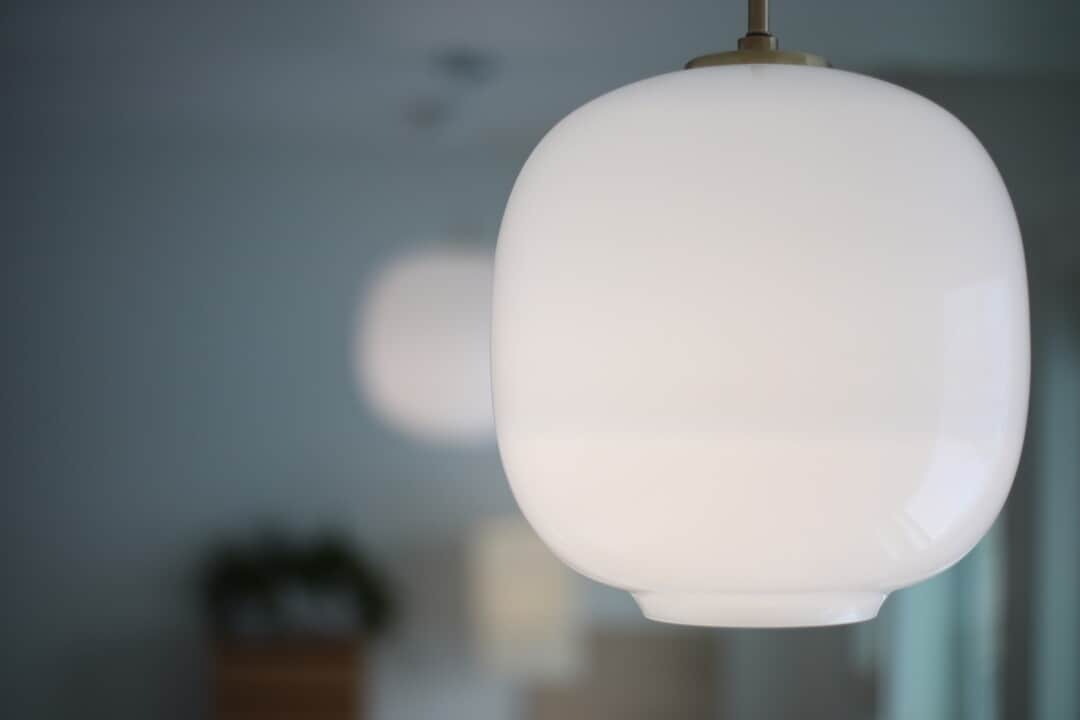After reviewing the Artek Stool 60 a while back, today is time for another design review: the VL45 Radiohus pendant by the Danish brand Louis Poulsen. I recently got myself two of these pendants for my living room and kitchen, and though I’d share my thoughts on them with you.
As judging a design luminaire is largely an exercise in aesthetics, I decided that this time, I will keep the review less formal, skip the grades and just tell my experience with the Radiohus pendant. If you are considering getting one, I hope my comments may help you in deciding whether this lamp is for you, which version to get, and where it works the best.
What is it?
The Louis Poulsen VL45 Radiohus Pendant is a Danish minimalist spherical glass luminaire for ambient lighting.
Designed in 1940s by Vilhelm Lauritzen for the Danish broadcasting house in Copenhagen, the lamp has quite some history behind it. Although not quite as popular as the PH5 of the same brand, the timeless Radiohus pendant has reached a similar status as a design icon.
The Radiohus pendant is characterized by its rounded three-layer hand-blown opal glass shade and brass fittings. It comes in three sizes with shade diameters between 175 and 370 mm, or 7” and 14½”, and is available in both European and US voltage versions.
Averaging a little under £500, €500 or $700, the VL45 Radiohus is not cheap, but affordable for a design light, making it one of the more accessible pieces of design out there.
Packaging
The pendant arrives in a brown cardboard box which is, considering the price point of the product, surprisingly plain, even disappointing.
Inside, however, you will find the pendant in a masterpiece of packaging: the glass sphere of the pendant is surrounded by a sectored bent cardboard cradle. This cradle keeps both the valuable sphere tightly in place and provides buffer space against impacts to the exterior box. This is one of the neatest packagings I have ever seen.
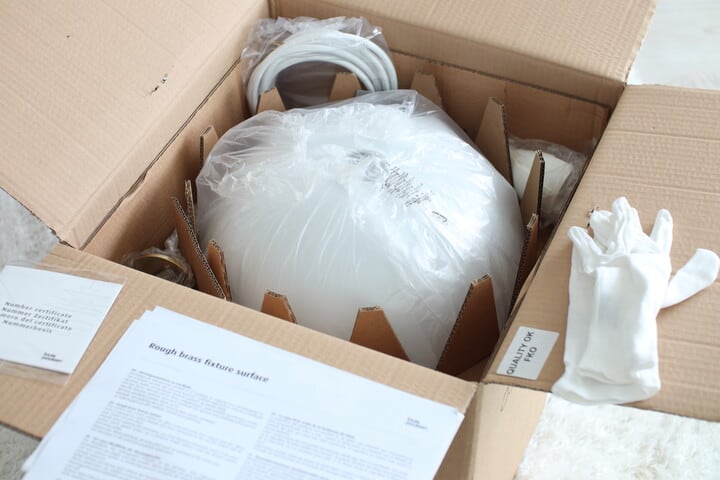
The package also includes the brass fittings for the pendant, the extra-long 12′ cord, the canopy and the socket, placed in the free corner space in the box. The packaging of these parts is nothing special, but enough to keep them from scratching each other or the valuable main glass. Interestingly, a pair of white cotton gloves is also included, although their purpose remains unclear to me, even after reading the instructions.
Assembly
The assembly of the VL45 Radiohus pendant is very simple. The pendant consists of only six parts: the glass shade, a brass cap and stem, the socket, a canopy and cord. None of the assembly steps requires tools.
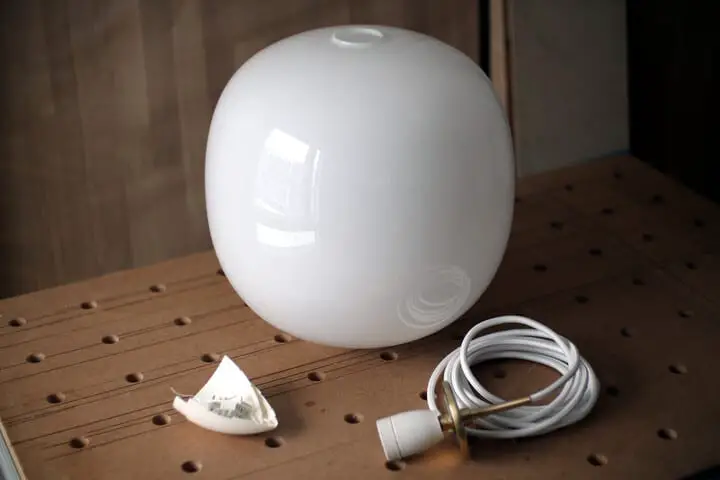
The biggest challenge in assembly is finding the courage to handle the glass. It is heavy, smooth, perfect, and menacing. The glass feels every bit as expensive as it is, and your are instinctively extra careful when touching it. The included white gloves feel appropriate, bit also slippery.
Once you overcome the initial caution and screw the brass cap and stem onto the top opening of the glass, you are pretty much set. The picture instructions make the required few steps easy to follow.
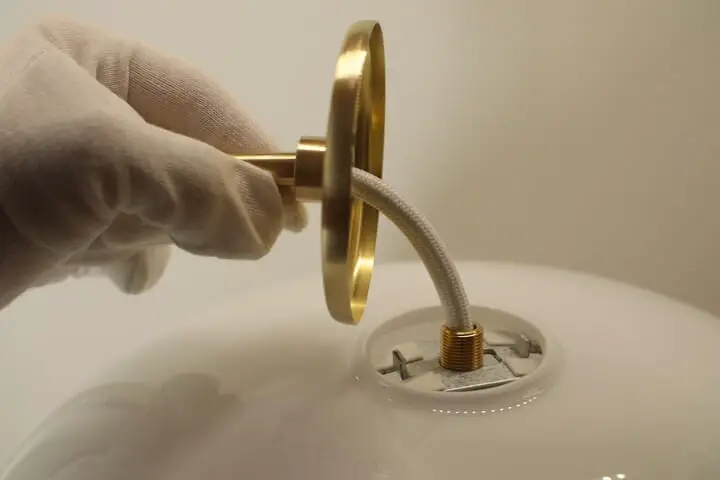
Installation
Hanging the pendant and plugging it in goes more or less as with any other pendant light, but a few points are worth noting.
First, compared to most modern plastic luminaires, the Radiohus pendants are heavy, the large 370 version weighing a hefty 9 lb (4.5 kg). These pendants need a solid hook for hanging.
Also double-check the tightness of the strain relief clamp on the eyelet piece. This clamp grips the cable and should carry the whole pendant weight without slipping. Failure here may turn very expensive.
After you have hung the Radiohus pendant, you need to balance it so that it hangs straight. This is done by shifting the brass cap in the shade top opening. The pendant shades are hand-blown and not totally symmetric, but you should get them reasonably true and plumb.
Last, the VL45 Radiohus pendant comes with an extra long 12-ft cord. This length allows for very tall hangs and gives you more routing options than average. However, if you use only a few feet of it, beware that all the extra length is unlikely to fit into the included small canopy.
The cord to can be cut to length as the instructions suggest, but I was reluctant to do this. After all, I may later want to move the pendant to a taller spot, or sell it. I solved the issue for now by coiling it around the ceiling outlet without the canopy. Later, I may get a larger replacement canopy that fits the whole cord.
Build quality
I found both of my VL45 Radiohus pendants to be built to a very high standard and with excellent quality.
The glass shades are uniform, smooth and precise, without any variation in translucence, gloss or shape. When powered, the evenness of the glass surface brightness seems almost unreal.
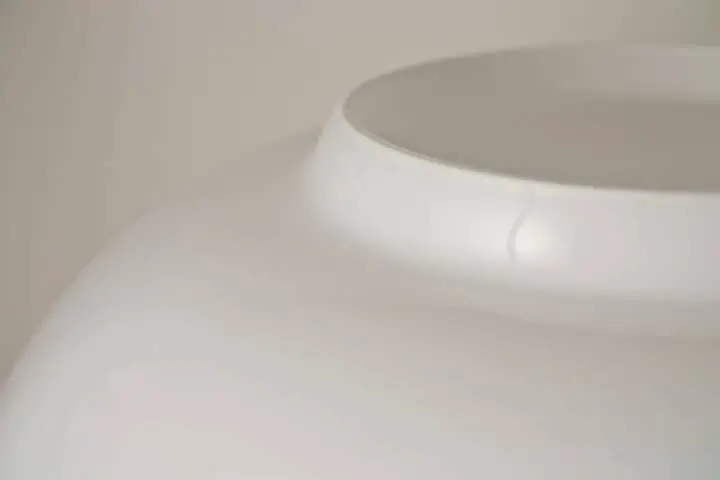
The brass fittings are precisely machined and brushed to a consistent semi-glossy finish. The parts were still totally bright, and the patina that the instructions warn of had not set in.
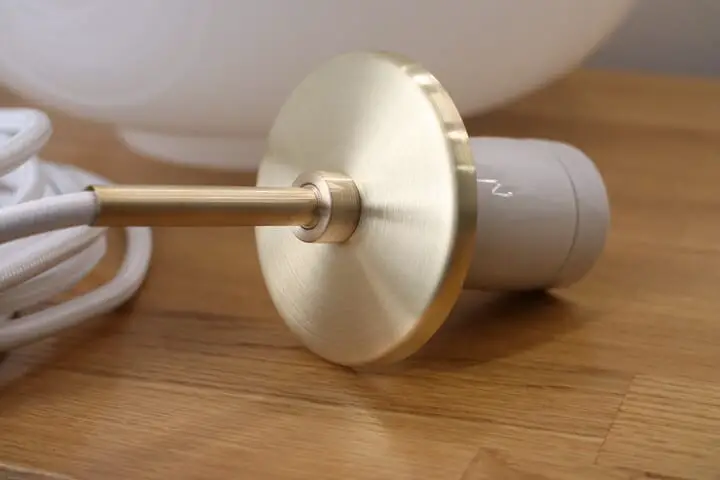
In terms of design flaws or manufacturing quality issues, there is not much to say – I could not find anything substantial. The instructions mentioned slight geometry imperfections and bubbles in the glass as possible and part of the normal production quality. I was unable to detect any bubbles, but the balancing process indicated that my larger Radiohus 370 may be just a bit asymmetric.
Appearance
Soft and rounded, the VL45 Radiohus pendant resembles the natural form of a berry or a flower bell. The slightly sharper shoulders and straightened sides establish it as the work of a human hand.
To me, the VL45 Radiohus achieves a rare balance between natural and artificial. It is neither harshly geometric nor overly organic and fluid, thus avoiding the excesses of both modern and contemporary furniture design.
The smooth and simple lines make the pendant calm and harmonic, while the shoulders and brass fittings give it structure and definition. The shape is as simple as naturally possible without lapsing into geometricity. Ornament is minimal to non-existent.
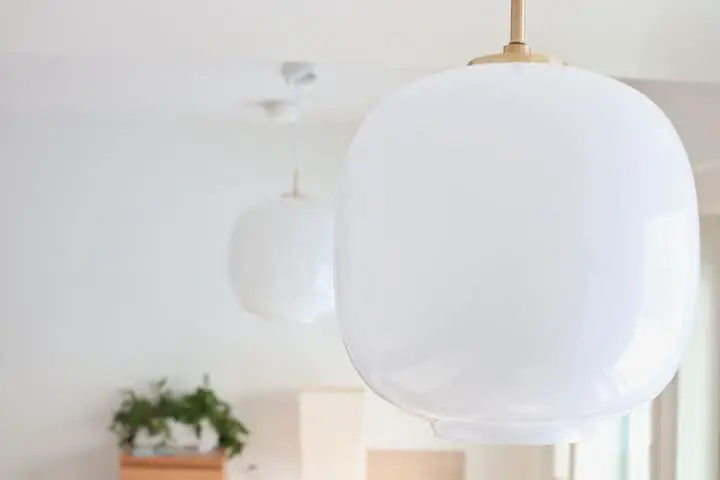
Through choice of materials, the pendant gives off a classy and valuable but discreet image. The three-layer clear–opal–clear glass is an interesting combination of glossy and opaque, and is pearl-like in its appearance.
The brass fittings are machined and brushed; as new, they are golden bright, but will develop a patina with time. The white braided cord is an excellent match to the rest of the pendant, which would not enjoy a regular PVC jacket cable.
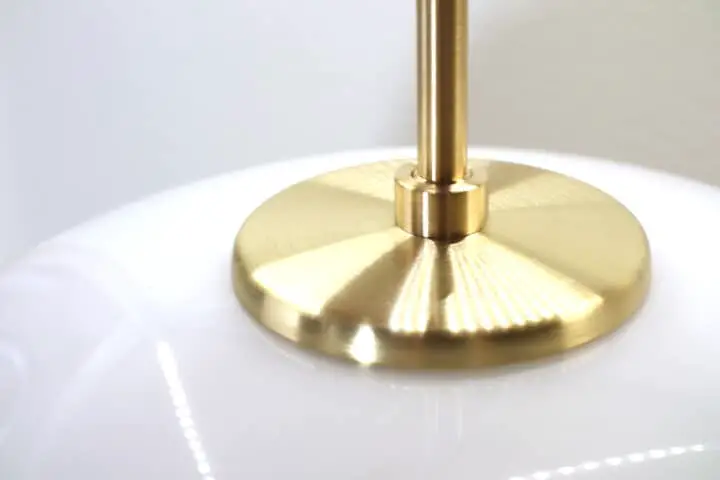
Light
The Louis Poulsen VL45 Radiohus pendant also works well in its real function – lighting.
The pendant radiates light relatively equally to all directions, making it an excellent source of ambient light. The distribution of light is very even, and no pattern is obvious to the naked eye.
The bottom hole does still give some focus light right under the pendant. This provides some task lighting when the pendant placed above a table. However, I found this focusing to be quite moderate and the edges gradual, so that no disturbing patterns are visible at floor level.
Thanks to the three-layer opaline shade, the VL45 light is very smooth and diffuse. Thanks to the practically 360 shading, there is also no glare from any practical viewing direction, even at high luminous powers. I found the glow of the lamp incredibly even and pleasing to watch.
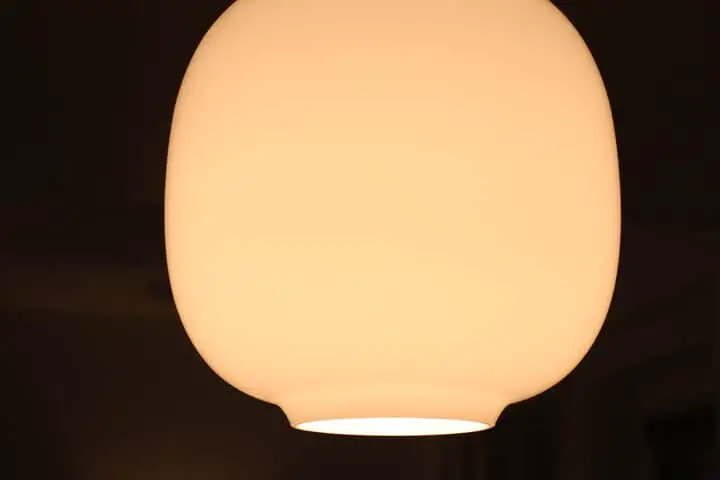
Where to install?
The Louis Poulsen VL45 Radiohus pendant is an ambient light, and thus very versatile. The pendant can be placed in living rooms, bedrooms, hallways and some kitchen locations.
The pendant is aesthetically at its best in tall spaces with plenty of height. As with chandeliers, the longer the suspension distance and headspace, the better the Radiohus pendant looks.
Placement above dining and coffee tables or kitchen islands is optimal, as these spots often allow you to bring the pendant further down without risking conflict with heads. Hallways and open spots are more challenging in terms of head clearance, but are just fine if the room height is above 9′.
The Radiohus pendant can also take limited service as a task light. Although the focus light under the pendant is not very strong and should be complemented with a table lamp in precision work such as reading, writing or drawing, it is enough for a computer workstation.
For which size to install where, see my comments under Versions below.
Installation heights
Kitchen island: Above a kitchen island, the VL45 Radiohus pendant should be installed following the general guidelines: lowest point 30” to 36” from island top. This gives you enough clearance for work without risk of hitting the pendant. With the medium size Radiohus 250 in a 9-foot room, this means around 2′ of cord above the pendant; in a 8-foot space, around 1′. The Radiohus is slim, glare-free, and looks better with longer cord, so you may prefer the lower end of the range.
Dining table: As with other pendants, the VL45 Radiohus should have a 30” to 36” clearance from a dining table top. With the medium size Radiohus 250 in a 8- or 9-foot room, this means a few feet of cord above the pendant. The Radiohus pendant is much less obtrusive than a chandelier and glare-free, so you could experiment with even lower heights.
Hallway: The standard pendant light height in a hallway is 7′ from the floor, or 6” above the lintel. With a 9′ ceiling height, this rule leaves you around 1′ of cord with the medium-size Radiohus 250 pendant, which is not much but still OK. The pendant is not really suited to 8′ hallways, unless you are willing to hang it right at the ceiling (inaesthetic) or lower than normal (collision risk with tall people). In long and narrow hallways you may consider an array of two or three smaller Radiohus 175’s which are shorter and look decent with less cord.
Versions
The VL45 Radiohus pendant is available in three sizes: the VL45 Radiohus 175, 250 and 370, with a diameters of 175 mm (7”), 250 mm (10”) and 370 mm (14½”), respectively.
Radiohus 370
The large VL45 Radiohus 370 is an impressive piece of glass. At 370 mm or 14½” in diameter, its size approaches that of popular lightweight plastic pendant lights, but being of glass, has considerably more heft to it.
The Radiohus 370 is more rounded than the smaller versions, and its appearance demands more room. It is at its best in a single configuration in a living room or other large space.
Radiohus 250
The medium size VL45 Radiohus 250 is clearly the most versatile size. It suits all but the largest of living rooms even in a single-lamp configuration, and is not too bulky in a small kitchen. It works well as a linear array over long tables or in hallways, and appears natural in irregular, multi-level setups as seen in some of the product photos.
Radiohus 175
The small size VL45 Radiohus 175 is actually a very recent addition, brought to the lineup only in 2019. The glass part looks exactly like in the medium 250, only smaller; the brass stem is relatively longer than on other versions.
The Radiohus 175 is really a very small lamp and would look out of place as the main light of any typical room. The 175 is rather suited for use as a focus light above small desks, or as dining table light in a twin or triple configuration. As a linear array of two or three, I imagine it would also work well in a narrow hallway.
Replacement shades
The VL45 Radiohus pendant are basically large hollow spheres of glass and may break.
Fortunately Louis Poulsen has made the shades available as a replacement part, so that you do not have to buy a whole new lamp after an unfortunate knock or bump. Costing around 2/3 of the pendant price, the replacement shades are not cheap, but will still save you money.
Availability of these shades does not seem to be all that great, though. The only retailer that stocking the shades I found is the Danish Lampemesteren, with mainly European delivery. Other retailers may also be able to get them for you, although they do not list the parts online.
Where to get it?
Finnish Design Shop: This online design retailer carries the Radiohus pendant in all sizes and both the European 230V and the US 120V versions. Ships to over 180 countries. Very competitive in Europe, US delivery is around $50 and takes a week.
Danish Design Store: A US-based online design retailer with US versions of all VL45 Radiohus sizes. Free US shipping above $75, that is, for all Radiohus pendants.
Connox: A German online shop with European 230V versions of all Radiohus pendant sizes listed. Very competitive in Europe, often free shipping for Radiohus pendant within Europe.
Design Within Reach: A brick-and-mortar retailer with a wide US presence. Carries US versions of Radiohus 250 and 370. You may be able to see the pendant in their stores.
Used
As the VL45 Radiohus pendants do not really wear with use and are not cheap to buy new, there is a healthy aftermarket for pre-owned Radiohus pendants.
As with many other used design luminaires, it’s a seller’s market, though. There are few to no Radiohus pendants on sale in Ebay at any given time, and at Franckly.com, a European pre-owned design marketplace, around 100 potential buyers have signed up for listings that are not even there yet.
Finding a used VL45 Radiohus pendant is possible, but means you have to be on the watch for some time, and quick on the trigger.
